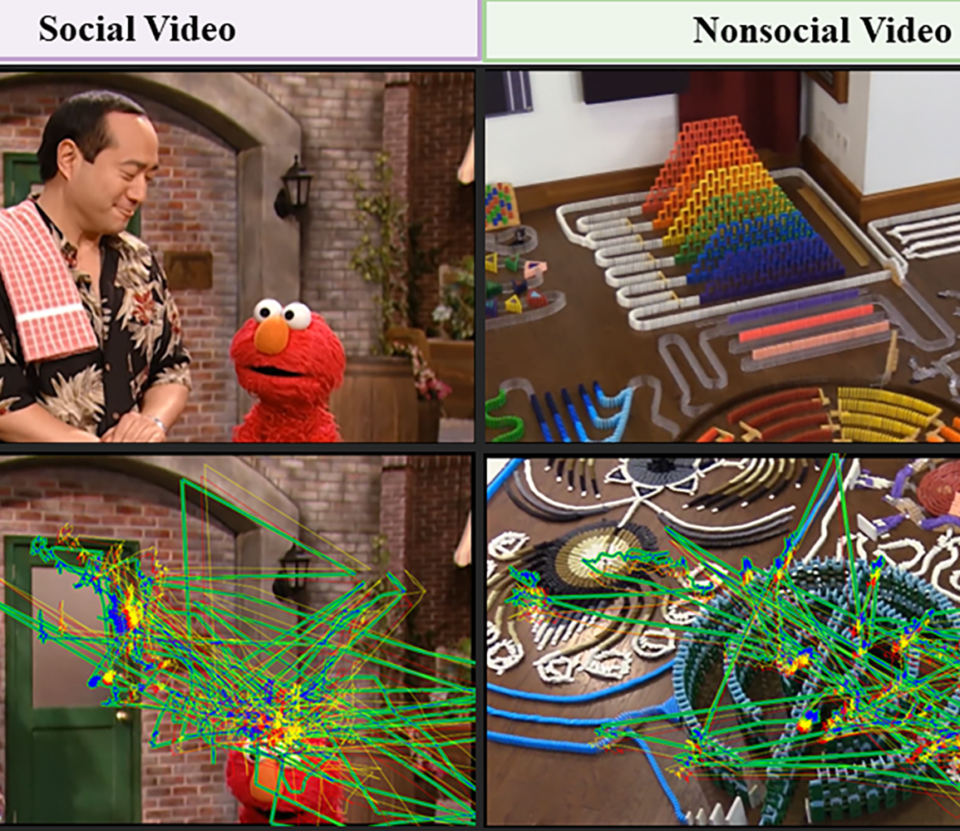Development of Attention and Cognitive Control Functions in Childhood
Our previous work has shown that there are individual differences in how infants attend to emotionally salient social information (e.g., angry faces). The early-emergent individual differences in affect-biased attention play a critical role in shaping trajectories of socioemotional development. Cognitive control functions serve to regulate attention and behavior. Early childhood (4 to 7 years) is marked by rapid development of cognitive control functions and the onset of socioemotional problems. Understanding the dynamic interactions between affect-biased attention and cognitive control might provide a key to understanding why some children develop socioemotional problems while others do not.
The project examines the development of affect-biased attention and cognitive control functions during childhood by using a battery of tasks incorporating eye tracking and functional near-infrared spectroscopy (fNIRS) recordings. We characterize the neurocognitive mechanisms underlying children’s attention and cognitive control functions. We also study how individual differences in these functions influence the way that children interact with the social environment and their socioemotional adjustment outcomes.
Early Development of Attention Functions Related to Risk for Autism Spectrum Disorder (ASD)
Reduced attention to social information is a promising biomarker for ASD. In collaboration with Dr. Jessica Bradshaw at USC, we aim to identify social attention patterns and characterize developmental trajectories of social attention associated with early risk for ASD, before a reliable ASD diagnosis can be determined. In the longitudinal study, we assess infants between 1 and 36 months in narrow age intervals. Infants’ attention is measured using eye tracking, lab observations, and parents reports in various task contexts. We also examine infants’ motor, social communication, and language abilities.
Mapping Scalp-to-Cortex Locations Across the Lifespan
Functional near-infrared spectroscopy (fNIRS) is a noninvasive technique that uses sensors placed on the scalp to indirectly measure neural activities in response to the task stimuli. A key advantage of the technology is its ease of use with participants of different ages, hence, allowing researchers to track neurodevelopment across the lifespan. fNIRS data collection, data analysis, and result interpretations require making anatomical inferences about the correspondence between scalp and cortical locations. In collaboration with Dr. John Richards at USC, we leverage the open-access Neurodevelopment MRI Database to compute probabilistic scalp-to-cortex mapping for a wide age range across infancy and adulthood. The products of this project (see also Resources) will help researchers to make anatomical inferences about NIRS/fNIRS data, especially for studies where the participants’ own MRI scans cannot be collected or are unavailable.
Early Predictors of Infant-Parent Coordinated Attention and Word Learning in Preterm and Full-Term Infants (@WL Study)
This NIH-funded study (R21 HD113861) aims to gain better understanding on early predictors of disruptions in language learning. Preterm (PT) birth is associated with elevated risks for language impairments, but we know little about why and how PT-related individual differences in language acquisition emerge. The present proposal will examine infant-parent coordinated visual attention as a key mechanism underlying the development from PT-induced alterations in basic attention functions and motor abilities to real-time word learning performance.
In this longitudinal study, comprehensive assessments of infant attention and motor abilities will be carried out at 12 months of age. Basic attention functions will be examined using three screen-based eye-tracking tasks. Infants’ motor skills will be assessed using a standardized assessment. At 18 months, we will incorporate mobile eye tracking in an infant-parent free-play session to study coordinated visual attention (i.e., joint attention) from a first-person perspective. The study findings will shed light on the developmental cascades from PT birth and help identify clinically useful predictors of PT-related language impairments.
The Neurocognitive Bases of Executive Functions and the Impacts of Individual and Environmental Factors (CUBE Study)
Executive functions (EF) are a constellation of neurocognitive abilities that support top-down control of thought. EF skills are subserved by widespread neural networks. EF abilities and the underlying neural functions have a protracted development starting from infancy and extending into adulthood. Given EF plays a critical role in supporting learning and socioemotional functioning, the efforts of promoting healthy development and detecting risk markers for psychopathology depends on 1) a comprehensive understanding of neural mechanisms underlying subfunctions of EF and 2) identifying predictors that drive individual differences in neural functions of EF that are implicated in shaping downstream developmental outcomes. The overarching aims of the study are to examine individual and environmental factors that influence the neural functions underlying EF and gain a deeper understanding of the impact of EF on socioemotional development.
The first part of the study examines age-related differences in behavioral and neural measurements of EFs in participants from three age groups: 4-7 years, 18-24 years, and 60 years above. Early childhood is marked by rapid neural maturation underlying EF and normative shifts in parent-child relationships and children’s social and educational environments. The second part of the study examines the predictors and downstream effects of EFs on socioemotional functioning in young children (4-7 years).
Findings from Part 1 will inform age-related differences in neural mechanisms underlying EF. They will inform quantitative (levels of neural activation) and quantitative (strategy use) changes in EF across a wide age range. Findings from Part 2 will facilitate the identification of at-risk children who may be vulnerable to developing EF deficits. They will also inform our understanding of malleable risk mechanisms contributing to the development of socioemotional problems in children.






